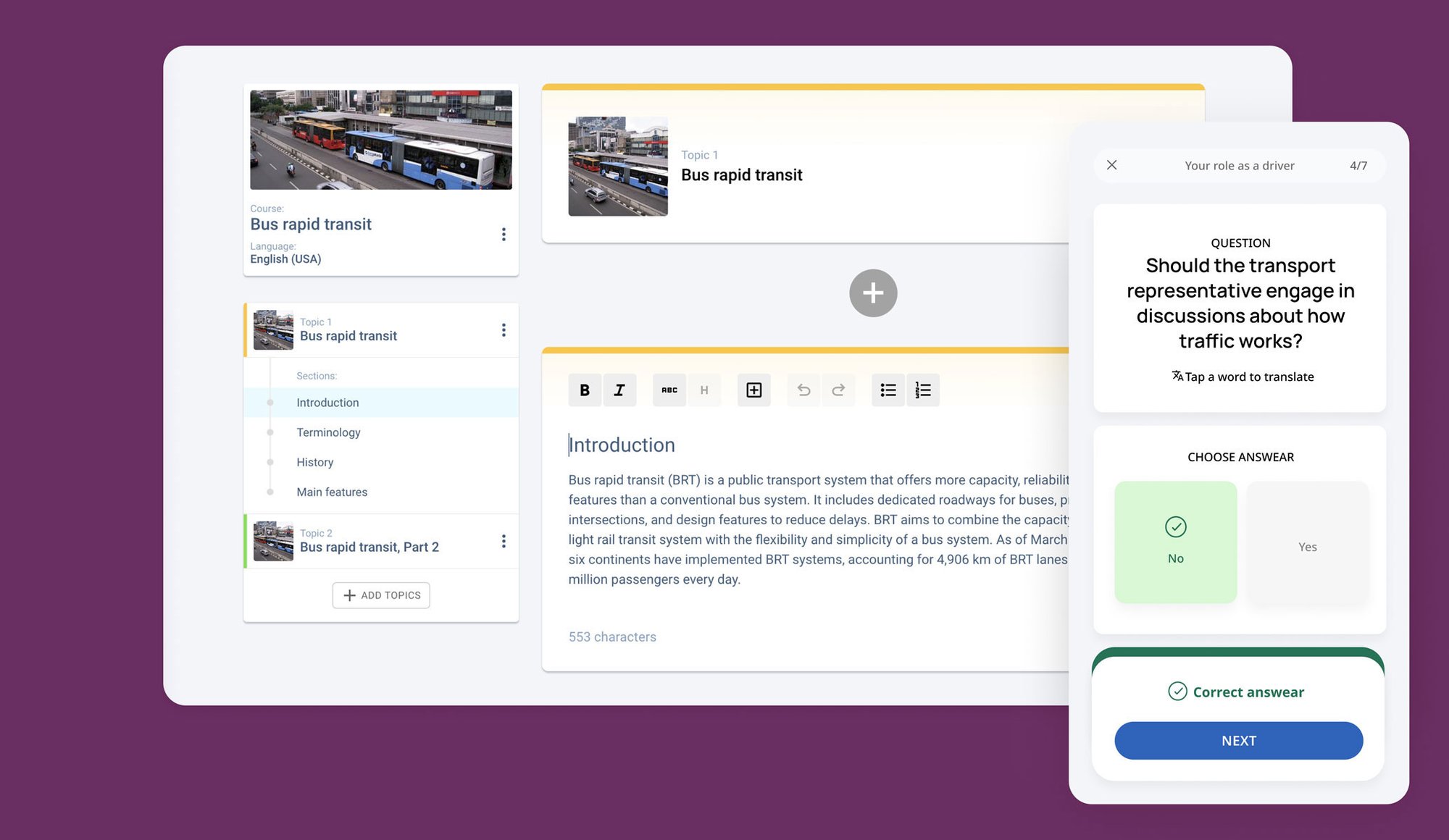Organisations invest significant resources in training and development programs to enhance their employees' knowledge and skills. However, it is crucial to measure the effectiveness of these initiatives to ensure that they deliver tangible results. By tracking key performance indicators (KPIs) and training metrics, organisations can gain valuable insights into their training programs' impact and make data-driven decisions to drive continuous improvement.
Learner engagement metrics
Engaging learners is paramount to the success of a learning management system or any training program. When fully engaged, participants are more likely to grasp new concepts, retain information, and apply what they have learned daily. Several metrics can help assess learner engagement:
1. Course completion rates
Measuring the percentage of participants who complete a training course indicates learner commitment and the effectiveness of course design and delivery.
2. Attendance rates
The number of participants attending training sessions determines interest and engagement. Higher attendance rates and training statistics suggest that learners actively seek knowledge and value learning opportunities.
3. Learner feedback scores
Gathering feedback from learners about their training experience can provide valuable insights into engagement levels. Feedback surveys or interviews can help identify areas for improvement and gauge overall satisfaction.
4. Time spent on training
Tracking learners' time in training activities is an essential metric to assess engagement. Longer durations indicate a thorough engagement with the material, whereas shorter durations may imply disinterest or distraction.
5. Engagement in learning activities
Monitoring the participation and interaction levels in learning activities, such as discussions, group projects, or online forums, can offer insights into the level of engagement and collaboration among learners.
However, learner engagement is more than just dependent on these metrics. Various other factors also influence it. For instance, the relevance of the training content plays a significant role in capturing learners' attention and maintaining their interest. When learners perceive the training material as directly applicable to their work or personal development, they are more likely to participate actively in the whole learning and development process.
Furthermore, the delivery method of the training can impact learner engagement. Interactive and dynamic training sessions that encourage active participation, such as role-playing exercises or hands-on activities, tend to foster higher engagement levels than passive learning methods, such as lectures or slide presentations.
Additionally, the learning environment can contribute to engagement. Creating a supportive and inclusive atmosphere where learners feel comfortable asking questions, sharing ideas, and collaborating with their peers can enhance engagement. This can be achieved through group discussions, team-building exercises, or virtual platforms facilitating interaction and knowledge sharing.
Knowledge acquisition and retention metrics
While learner engagement is crucial, the ultimate goal of training programs is to equip participants with the knowledge and skills required for their roles. The following metrics measure knowledge acquisition and retention:
Monitoring and evaluating the effectiveness of training programs is a multifaceted process that goes beyond just measuring learner engagement. It involves tracking employee training and assessing the impact of the training on participants' skills and knowledge retention over time. By utilising a range of metrics, organisations can gain valuable insights into the effectiveness of their training initiatives.
6. Skills improvement rate
Assessing the rate at which learners improve their skills after training indicates the training program's effectiveness. This can be measured through pre- and post-training assessments or supervisor evaluations of training progress. By tracking the progression of skills development, organisations can identify areas of strength and areas that may require further focus or support.
7. Certification rates
Tracking the number of participants who obtain certifications or qualifications related to the training program is an essential metric to gauge the level of knowledge acquisition of new skills and expertise among learners. Achieving certifications not only validates the participants' learning but also demonstrates their commitment to continuous professional development.
8. Long-term retention rates
Measuring the extent to which learners retain and apply knowledge over the long term is crucial. Regular assessments after the training program can help determine knowledge retention levels and identify areas for reinforcement or additional training. By evaluating long-term retention rates, organisations can ensure that the knowledge imparted during training is absorbed, retained, and applied in real-world scenarios.
9. Knowledge application rate
Assessing the extent to which learners apply the soft skills and knowledge gained in training to their daily tasks and responsibilities provides a measure of the program's practical relevance and impact on job performance. The ability to transfer learning from the training environment to the workplace is a crucial indicator of the training program's effectiveness in equipping participants with practical skills that enhance their performance and productivity.
Business impact metrics
While these training courses and programs primarily focus on individual skill development, they should also positively impact the organisation as a whole. The following metrics assess the business impact:
10. Return on investment (ROI)
Return on Investment (ROI) is a crucial metric that helps organisations evaluate the financial benefits of their training programs. By comparing the costs invested in employee training programs with the resulting benefits, organisations can determine whether the training initiatives are worth the expenditure. This metric considers various factors, such as increased productivity, reduced errors, and improved employee performance, to provide a comprehensive view of the program's impact on the organisation's bottom line.
11. Employee productivity rate
Tracking the Employee Productivity Rate provides valuable insights into the effectiveness of training programs. Organisations can gauge the workplace training program's impact on individual and team performance by measuring employees' productivity levels before and after training. This metric helps identify whether the training has equipped employees with the necessary skills and knowledge to enhance their productivity and contribute to the organisation's overall success.
12. Impact on key performance indicators (KPIs)
Identifying and measuring the influence of training programs on key performance indicators, such as sales revenue, customer satisfaction, or employee turnover, provide tangible evidence of their impact on business outcomes.
The Impact on Key Performance Indicators (KPIs) metric enables organisations to assess the direct influence of training programs on critical business outcomes. Organisations can measure the program's impact on these areas by aligning the training objectives with key performance indicators, such as sales revenue, customer satisfaction, or employee turnover. This metric provides tangible evidence of how training initiatives contribute to achieving organisational goals and driving success.
13. Customer satisfaction scores
Training programs that directly impact customer interactions, such as customer service or sales training, should be monitored through customer satisfaction surveys. Higher satisfaction scores suggest that trained employees are delivering better customer experiences.
Monitoring customer satisfaction scores is essential for training programs directly impacting customer interactions. By conducting regular customer satisfaction surveys, organisations can gather feedback on the quality of customer experiences delivered by trained employees. Higher satisfaction scores indicate that the training has successfully equipped employees with the skills and knowledge required to provide exceptional customer service, ultimately leading to increased customer loyalty and business growth.
14. Employee turnover rate
High employee turnover can be a costly concern for organisations. Training programs that effectively engage and develop employees can contribute to lower turnover rates, positively impacting employee retention and organisational stability.
The Employee Turnover Rate metric measures employee training statistics and the effectiveness of training programs in improving employee retention and organisational stability. High employee turnover can harm an organisation, increase recruitment and training costs, and cause the loss of valuable talent and institutional knowledge. By implementing training programs that effectively engage and develop employees, organisations can reduce turnover rates, positively impacting employee satisfaction, loyalty, and long-term commitment.
By considering and measuring these additional metrics, organisations can understand the business impact of their training programs. This enables them to make informed decisions and continuously improve their training initiatives.
Operational efficiency metrics
In addition to the gains in individual and organisational performance, training programs should also consider the impact on operational efficiency and cost-effectiveness. The following metrics assess operational efficiency:
15. Cost per trainee
Calculating the cost per trainee helps organisations determine the cost-effectiveness of their training programs. Organisations can optimise their training budgets by comparing the total expenses with the number of participants and identifying areas for cost reduction.
Understanding the cost per trainee is crucial for organisations to allocate their resources effectively. It provides insights into the financial investment required for each participant, enabling companies to make informed decisions about allocating training budgets. By monitoring this metric regularly, organisations can identify trends and patterns in training costs, allowing for strategic adjustments to enhance cost-effectiveness.
16. Training program scalability
As organisations grow and evolve, the scalability of employee training programs becomes vital. Assessing the ease of scaling up training initiatives allows organisations to accommodate increasing employee numbers without compromising the program's effectiveness or quality.
Scalability is not just about increasing the number of participants; it also involves adapting the training content, delivery methods, management systems, and resources to meet the evolving needs of a growing workforce. Organisations prioritising scalable training programs can seamlessly expand their learning initiatives to support business growth and development. By evaluating the scalability of training programs, organisations can proactively plan for future expansion and ensure that training remains a sustainable and adequate investment in their workforce.
Optimising success by leveraging key training metrics with Lingio
By measuring these essential training metrics and KPIs, organisations can gain valuable insights into the effectiveness of their training programs and make informed decisions to enhance employee skills, boost productivity, and improve business outcomes. Successful training programs require continuous evaluation and improvement to remain practical and relevant.
In continuous employee development, Lingio emerges as a pivotal ally for organisations seeking to bridge the skill gaps and enhance their workforce's capabilities. By embracing Lingio's cutting-edge learning solutions, companies can unlock interactive and immersive training resources that cater to diverse learning preferences and schedules. Lingio's platform is designed to make learning engaging, effective, and accessible, transforming traditional training into a dynamic, enjoyable journey towards knowledge acquisition and skill mastery.
With Lingio, you can tailor courses to meet your organisational goals and workforce needs, ensuring your team meets and exceeds their potential. Take the first step towards redefining your training strategy with Lingio and propel your organisation toward a future of empowered, skilled, and motivated employees. Discover Lingio to revolutionise your training programs and drive your organisation to new heights of employee engagement and success.
FAQs
1. How can we accurately measure the ROI of training programs?
Understanding the ROI involves comparing the program's costs against the productivity, efficiency, or revenue gains directly attributed to the employee training progress. Before the program begins, setting clear objectives and metrics for accurate measurement is crucial.
2. What strategies can enhance learner engagement in training programs?
To boost engagement, consider incorporating interactive elements such as gamified learning experiences, real-world projects, and collaborative activities. Tailoring content to meet learners' specific roles and interests can also significantly increase engagement.
3. How does training affect employee retention rates?
Effective training programs can increase employee satisfaction by demonstrating an investment in their career growth. This leads to increased loyalty and lower turnover rates. Continuous learning opportunities are often cited as a critical factor in an employee's decision to stay with an organisation.
4. Can training programs impact customer satisfaction, and how?
Absolutely. Training programs, especially those focused on customer service, communication, and problem-solving skills, directly enhance the quality of service employees provide to customers. This, in turn, can lead to improved customer satisfaction scores and loyalty.


Table of contents
Intro
Learner engagement metrics
Knowledge acquisition and retention metrics
Business impact metrics
Operational efficiency metrics
Optimising success by leveraging key training metrics with Lingio
FAQs


